Nissan S30
The Nissan S30 (sold in Japan as the Nissan Fairlady Z and in other markets as the Datsun 240Z, then later as the 260Z and 280Z) is the first generation of Z GT two-seat coupes, produced by Nissan Motors, Ltd. of Japan from 1969 to 1978. One of the most successful sports car lines ever produced, the trend-setting S30 was designed by a team led by Yoshihiko Matsuo, the head of Nissan's Sports Car Styling Studio.
| Nissan 240Z, 260Z & 280Z | |
|---|---|
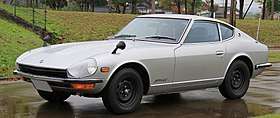 1970-1973 Nissan Fairlady Z | |
| Overview | |
| Manufacturer | Nissan |
| Also called |
|
| Production | 1969–1978 |
| Assembly | Japan: Hiratsuka, Kanagawa (Nissan Shatai Plant) |
| Body and chassis | |
| Class | Sports car |
| Body style | |
| Layout | FR layout |
| Chronology | |
| Predecessor | Datsun Sports |
| Successor | Nissan 280ZX (S130) |
Seeking to compete head-to-head with established European sports cars, Datsun priced the new 240Z within $200 of the British MGB-GT in the United States, a five-year-old design that showed its age. The 240Z's sleek styling, modern engineering, relatively low price, and impressive performance struck a major chord with the public. Positive response from both buyers and the motoring press was immediate, and dealers soon had long waiting lists for the "Z".
As a "halo" car, the 240Z broadened the acceptance of Japanese car-makers beyond their econobox image. Datsun's growing dealer network compared to limited production imported sports cars manufactured by Jaguar, BMW, Porsche, Alfa Romeo, and Fiat ensured both easy purchase and ready maintenance.
All variants of the S30 have four-wheel independent suspension consisting of MacPherson struts in front (borrowed from the Nissan Laurel C30) and Chapman struts in back. Front disc brakes and rear drums were standard.
The 240Z used twin SU-style Hitachi one-barrel side-draft carburetors. These were replaced on the 260Z with Hitachi one-barrel side-draft carburetors beginning with model year 1973 to comply with emissions regulations, resulting in diminished overall performance. A Bosch designed L-Jetronic electronic fuel injection was added to US market 280Zs in 1975 to compensate.
Continuing through the 1975–1978 model years, other non-US markets still received the 260Z coupé and the 260Z 2+2 hatchback—the two-door, four-seat model. The S30 240Z is unrelated to the later 240SX, which is sold as the Silvia in Japan.
Fairlady
The Fairlady Z was introduced in late 1969 as a 1970 model, with the L20 2.0-litre straight-six SOHC engine, rear-wheel drive, and a stylish coupe body. The engine, based on the Datsun 510's four-cylinder, produced 130 hp (96 kW) and came with a five-speed manual transmission.
Fairlady ZG
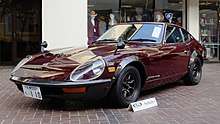
The Japan-only HS30-H Nissan Fairlady ZG was released in Japan in October 1971 to homologate the 240Z for Group 4 racing. Differences between the Fairlady ZG and an export-market Datsun 240Z include an extended fiberglass ‘aero-dyna’ nose, wider over-fenders riveted to the body, a rear spoiler, acrylic glass headlight covers and fender-mounted rear-view mirrors. The Fairlady ZG was available in three colours: Grande Prix Red, Grande Prix White and Grande Prix Maroon. The "G" in Fairlady ZG stands for "Grande." Although the ZG was not sold in the US and was never sold outside Japan, in order for it to be eligible for competition in the US, Nissan sold the nose kit as a dealer's option which is known as the "G-nose". With the nose added, these 240Zs are often referred to as 240ZGs, outside Japan.
Fairlady Z432
_front-right_Toyota_Automobile_Museum.jpg)
Packaging the 160 PS (118 kW) S20 engine (originally designed by the former Prince engineers) from the Skyline GT-R created a faster Fairlady. The Z432 (PS30) referred to 4 valves per cylinder, 3 Mikuni carburetors, and 2 camshafts. Approximately 420 were built.[1] Some Z432s were used by the police in Japan.
Fairlady Z432R
A Japan-only model Fairlady Z equipped with the twin cam 2.0 L inline six-cylinder "S20" engine shared with the KPGC10 Skyline GT-R was released in the Japanese domestic market (JDM) for homologation purposes (to enable its use as a rally car). The Z432R were all painted orange with black aluminum wheels and a low luster black hood. Z432R had lighter front guards, doors, and bonnet, as well as further engine enhancements over the Z432.
In January 2020 a 1970 Z432R sold at auction in Japan for a record A$1.17 million, about US$900000.[2]
240Z
| Datsun 240Z | |
|---|---|
.jpg) Datsun 240Z | |
| Overview | |
| Manufacturer | Nissan |
| Also called | Nissan Fairlady Z |
| Production | 1969–1973 |
| Designer | Yoshihiko Matsuo |
| Body and chassis | |
| Body style | 3-door coupé |
| Layout | FR layout |
| Powertrain | |
| Engine | 2.4 L L24 I6 |
| Transmission | |
| Dimensions | |
| Wheelbase | 2,305 mm (90.7 in)[3] |
| Length | 4,140 mm (163.0 in)[3] |
| Width | 1,626 mm (64.0 in)[3] |
| Height | 1,283 mm (50.5 in)[3] |
| Curb weight | 1,044 kg (2,301.6 lb)[3] |
| Chronology | |
| Successor | Datsun 260Z |
The 1970 240Z was introduced to the American market by Yutaka Katayama, president of Nissan Motors USA operations, widely known as "Mister K". The early cars from 1969 to mid-1971 had some subtle differences compared to late-71 to 1973 cars. The most visible difference is; these early cars had a chrome 240Z badge on the sail pillar, and two horizontal vents in the rear hatch below the glass molding providing flow through ventilation. In mid-1971, there were production changes, including exterior and interior colors, was restyling of the sail pillar emblems were with just the letter Z placed in a circular vented emblem, and the vents were eliminated from the hatch panel of the car, due to complains of exhaust being circulated into the car. Design changes for the US model 240Z occurred throughout production, but were not reflected in the JDM Fairlady, including interior modifications for the 1972 model year, and a change in the location of the bumper over-riders, as well as the addition of some emission control devices and the adoption of a new style of emissions reducing carburetors for the 1973 model year.
In Japan, it was exclusive to Nissan Japanese dealerships called Nissan Bluebird Stores, and was first introduced in Japan in 1969.
The 1970 models were introduced in October 1969, received the L24 2.4-liter engine with a manual choke and a four-speed manual. A less common three-speed automatic transmission was optional from 1971 on, and had a "Nissan full automatic" badge. In 2004, Sports Car International named this car number two on their list of Top Sports Cars of the 1970s.
Specifications
- Engine: 2,393 cc (2.4 L; 146.0 cu in) L24 inline-six engine, cast iron block, alloy head, two valves per cylinder, seven-bearing crankshaft, Direct Acting OHC, compression ratio 9.0:1; Maximum recommended engine speed 7,000 rpm.[4]
- Fuel system: Mechanical fuel pump, twin Hitachi HJG 46W 1.75 in (44 mm) SU-type carburetors[4]
- Power: 151 bhp (153 PS; 113 kW) at 5,600 rpm (SAE gross)
- Torque: 146 lb⋅ft (198 N⋅m) at 4,400 rpm (SAE gross)
- Transmission: Four-speed manual, five-speed manual, or three-speed automatic (after September 1970)
- Final drive ratios:
- Four-speed manual transmission: 3.364:1 (37:11)
- Five-speed manual transmission: 3.90:1 (39:10) (not available in US)
- Three-speed automatic transmission: 3.545:1 (39:11).
- Brakes:
- Suspension:
- Front: Independent with MacPherson struts, lower transverse and drag links, coil springs, telescopic dampers, anti-roll bar[4]
- Rear: Independent with Chapman struts, lower wishbones, coil springs, telescopic dampers[4]
- Steering: Rack and pinion,[4] 2.7 turns lock to lock
- Wheels: 4.5J-14 steel wheels with 175SR14 tires
- Top speed: 125 mph (201 km/h)
- 0 to 60 mph (97 km/h): 8.0 s
- Typical fuel consumption: 21 mpg‑US (11 L/100 km; 25 mpg‑imp)
World Rally Championship - round victories
In 1973, a 240Z, in the hands of Shekhar Mehta, won the 21st East African Safari Rally.[4]
No. Event Season Driver Co-driver Car 1 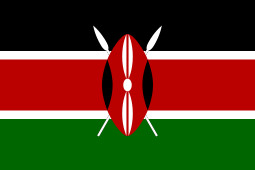
1973 

Datsun 240Z
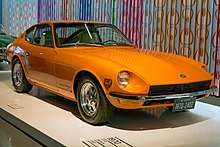 Datsun 240Z at the Shanghai Auto Museum |
 1970-71 Datsun 240Z Series I (US Model) in color code 907 racing green |
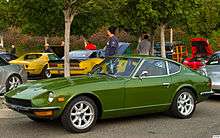 1971.5-72 Datsun 240Z Series II (US Model) in color code 113 green metallic |
1971 East African Safari rally car |
260Z
| Datsun 260Z | |
|---|---|
 Datsun 260Z 2-seater | |
| Overview | |
| Manufacturer | Nissan |
| Also called | Nissan Fairlady Z |
| Production |
|
| Body and chassis | |
| Class | Sports car |
| Body style | |
| Layout | FR layout |
| Powertrain | |
| Engine | 2.6 L L26 I6 |
| Transmission | |
| Dimensions | |
| Wheelbase | |
| Length | |
| Width | 1,626 mm (64.0 in) [5] |
| Height | 1,283 mm (50.5 in) [5] |
| Curb weight | |
| Chronology | |
| Predecessor | Datsun 240Z |
| Successor | Datsun 280Z |
The 260Z was sold in the United States for the 1974 model year only, but was available in other countries until 1978. The engine was enlarged .2 L to 2.6 L by lengthening its stroke. In the US, federal emissions regulations forced a reduction in ignition timing and compression ratio, resulting in a lower power output (140 hp) for the 260Z despite the additional displacement, whereas in other countries the power output increased to 165 bhp (123 kW; 167 PS). There was also a 1974.5 model sold through the second half of 1974 in the US that had the full 165 bhp (123 kW; 167 PS) with the addition of the larger 5 mph safety bumpers, that would become the standard for the 280Z.
A four-speed or 5 speed (non US) manual remained standard equipment, with a three-speed automatic transmission optional.
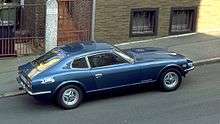
A 2+2 model built on a 11.9 in (302 mm) longer wheelbase was introduced, with larger opening quarter panel windows and a slightly notched roofline.
The 260Z claimed a few updates and improvements over the 240Z. The climate controls were more sensibly laid out and easier to work, and those cars with air conditioning now had the A/C system integrated into the main climate control panel. There was also additional stiffness in the chassis due to a redesign of the chassis rails which were larger and extended further back than previous models. A rear sway bar was added as well. The 260Z debuted a redesigned dashboard and console, as well as new seat trim, and door panels for the interior. The tail lights were updated, moving the back up lights from the main tail light housing to the back panel. Early 1974 US 260Z models had bumpers that resembled those of the earlier 240Z, though increased slightly in size, pushed away from the body somewhat, and wearing black rubber bumper guards rather that the previous chrome bumper guards with rubber strips. These early cars still had the front turn signals located below the bumpers. Late 1974 U.S. 260Z models (often referred to as 1974.5 models) carried the heavier bumpers that would remain on the 1975-76 model years of the 280Z so as to be in compliance with United States bumper legislation in 1973. These late cars had the front turn signals relocated to the outer edges of the front grill, above the bumper.
Specifications
- Engine: 2.6 L (160 cu in) L26 I6, cast-iron block, alloy head, two valve per cylinder, seven-bearing crankshaft, single overhead camshaft[4]
- Displacement: 156.6 cu in (2,565 cc)
- Bore: 83.0 mm (3.27 in)
- Stroke: 79.0 mm (3.11 in)
- Compression ratio: 8.3:1[4] (93 oct)
- Fuel system: Mechanical fuel pump, twin Hitachi HMB 46W[4] 1.75 in (44 mm) SU-type carburetors
- Power: 162 hp (121 kW) at 5,600 rpm (SAE gross)
- Torque: 157 ft⋅lbf (213 N⋅m) at 4,400 rpm
- Transmission: five-speed or four-speed manual or three-speed automatic
- Brakes:
- Suspension:
- Front: Independent with MacPherson struts, lower wishbones, coil springs, telescopic dampers, anti-roll bar[4]
- Rear: Independent with Chapman struts, lower wishbones, coil springs, telescopic dampers[4]
- Steering: rack and pinion, 2.8 turns lock to lock[4]
- Wheels/ tires: 5.5 by 14 in (140 by 360 mm) pressed steel wheels with 195VR14 radial tyres[4]
- Top speed: 127 mph (204 km/h)[4]
- 0 to 60 mph (97 km/h): 8.0 sec
- Fuel consumption: 20 to 28 mpg‑US (11.8 to 8.4 L/100 km; 24 to 34 mpg‑imp)
- Engine oil (sump): 9.0 Imp pints (5.1 liters/10.7 US pints)
- Tare weight: 1,350 kg (2,980 lb)
280Z
| Datsun 280Z | |
|---|---|
| Overview | |
| Manufacturer | Nissan |
| Also called | Nissan Fairlady Z |
| Production | 1975–1978 |
| Body and chassis | |
| Class | Sports car |
| Body style | |
| Layout | FR layout |
| Powertrain | |
| Engine | 2.8 L L28E I6 |
| Transmission | |
| Dimensions | |
| Wheelbase | 2,304 mm (90.7 in) 2,604 mm (102.5 in) (2+2) |
| Length | 4,399 mm (173.2 in) |
| Width | 1,631 mm (64.2 in) |
| Curb weight | 1,304 kg (2,875 lb) |
| Chronology | |
| Predecessor | Datsun 260Z |
| Successor | Datsun 280ZX |
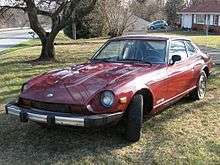
Nissan released the Datsun 280Z model for the North American market in the 1975 model year. In a further effort to keep the S30 models sporting in the face of increasingly stringent U.S. emission and safety requirements, engine size was again increased, this time to 2.8 L. The L26 engine was bored out .2 L to create the L28, and a Bosch L-Jetronic fuel injection system was added. Canadian versions were uniquely equipped without the anti-smog components mandatory in the States.
The 1975 and 1976 models continued to be fitted with the U.S. federally-required 5 mph (8.0 km/h) impact absorbing bumpers that were introduced for the mid-1974 model year of the 260Z. These bumpers were smooth surfaced, and blended into smooth black rubber extensions as they met the body of the car. The 1977 and 1978 models received bumpers with recessed channels added that blended into corrugated- or accordion-style black rubber extension trim. Also new for the 1977 model year, 280Zs no longer received the full-size spare tire, and instead had a "space saver" spare and a larger fuel tank. This resulted in a raised rear deck area made of fiberboard, reducing cargo space. In late 1976 and for most 1977–78 models, an optional five-speed manual transmission was available alongside the four-speed manual and the three-speed automatic options. It included a "5-speed" emblem on the left bottom edge of the rear hatch. For 1977 there was also an update from the charcoal painted hubcap style (with a chrome Z floating in the amber center emblems) to a hubcap that resembled an alloy wheel, bearing a center cap with a chrome Z floating in a black circle.
In 1977 and 1978 respectively, Datsun offered two special edition models. The "Zap" edition was offered in 1977 as a "special decor package". Zap cars were finished in "sunshine yellow" paint, and sported black stripes down the center and sides, with yellow, red, and orange chevrons at the front ends of the stripes. An estimated 1,000 "Zap Z" cars were offered in 1977. The "Zap Z" model was also used as the pace car in the 1977 Long Beach Gran Prix. The Black Pearl edition (produced in 1978) came with black pearlescent paint and a "special appearance package" (SAP), which consisted of dual racing mirrors, rear window louvers, and unique red and silver striping. It has been estimated that each United States dealer was allocated one Black Pearl edition to sell, though due to high demand some dealers reportedly received additional allocation. It is estimated 750 to 1,500 of these cars were ultimately produced, however the exact number remains unknown.
Both the two-seat and 2+2 coupe 280Z remained available throughout the 1975–1978 model year run. The S30 series was replaced in 1979 by the Nissan S130.
Specifications
- Engine: 2.8 L (170 cu in) L28E I6, cast-iron block, alloy head, seven-bearing crankshaft, single overhead camshaft
- Displacement: 168 cu in (2,753 cc)
- Bore: 86.1 mm (3.39 in)
- Stroke: 79.0 mm (3.11 in)
- Fuel system: electric fuel pump, Bosch L-Jetronic fuel injection
- Compression ratio: 8.3:1
- Power: 170 hp (127 kW) at 5,600 rpm (SAE gross)
- Torque: 163 ft⋅lbf (221 N⋅m) at 4,400 rpm
- Transmission: four-speed manual, five-speed manual, three-speed automatic
- Final drive ratio: 3.55:1
Racing

The Z was very successful in SCCA racing in the 1970s: Bob Sharp Racing out of Wilton, Connecticut with Sharp, Elliot Forbes-Robinson and later Paul Newman driving; and Brock Racing Enterprises (BRE) in the western US with John Morton driving a #46 240Z to the SCCA C Production national title in 1970 and 1971. Other drivers, such as Clearwater Florida (and later Maryland) racer Don Kearney had much success with the Z-car between 1970 and 1978. The Z and Datsun 510 are credited as catalyst for the US Japanese import performance parts industry. Nissan also supported and was associated with Bob Bondurant's race driving school from its inception.
In 2013 Nissan claimed its 97th SCCA national championship victory with Greg Ira at the wheel of his orange #2 RevTech 240Z.[7] On his way to his championship Ira set several road course records in SCCA's E Production class, beginning in 2006, including:
• Daytona International Speedway, Florida[8] • Heartland Park, Kansas • Homestead-Miami Speedway, Florida • Palm Beach International Raceway, Florida • Road America, Wisconsin • Sebring International Raceway, Florida • Virginia International Raceway, Virginia[9]
Ira was awarded SCCA's prestigious Kimberly Cup in 2008.[10] Previous Kimberly Cup recipients include Bob Holbert, Roger Penske, Mark Donohue, and Peter Revson.
On September 27, 2015, Greg Ira won his second (and Nissan's 98th) SCCA National Championship, in his EP2 Revtech/Ztrix.com 240Z, at Daytona International Speedway.[11]
Relaunch attempts
From 1997 to 2002 Nissan did not offer the Z-car line outside of Japan, where the Fairlady Z (Z32) remained available until 2000. In 1998, Nissan launched a program to bring back the Z-car line by first purchasing original 240Zs, then restoring them to factory specifications, and finally selling them to dealerships for $24,000. This was an effort to keep Z-car interest alive. Nissan over-estimated the market for the cars and low demand (and the high price) meant that less than fifty cars were re-manufactured and sold. Furthermore, in 1999, a concept car was shown to the public in a plan to return to the fundamentals that made the 240Z a market success.
References
Notes
- Zurschmeide, Jeff (June 2015). "1970 Nissan Fairlady Z 432". Sports Car Market. Vol. 27 no. 6. p. 75.
- Turner, Mandy (20 January 2020). "Old Datsun sells for $1.1 million, breaks auction records in Japan". caradvice.com.au. CarAdvice.com Pty Limited. Retrieved 30 April 2020.
- "Datsun specifications » 1969 Datsun 240Z". Carfolio. Retrieved 2013-12-26.
- Northey, Tom, ed. (1974). "Datsun". World of Automobiles. 5. London: Orbis. p. 498.
- "Datsun specifications » 1973 Datsun 260Z". Carfolio. Retrieved 2013-12-26.
- "Datsun specifications » 1973 Datsun 260Z 2+2". Carfolio. Retrieved 2013-12-26.
- "The Sports Car Club of America - Ira Declared EP National Champion At Runoffs". scca.com. Archived from the original on November 9, 2014.
- "Greg Ira's Revtec Team Sweeps Daytona". Classic Zcar Club.
- "Greg Ira's sweet sounding 240Z at VIR - MY350Z.COM Forums". MY350Z.COM Forums.
- "The Sports Car Club of America - Club Racing". scca.com. Archived from the original on January 30, 2015.
- "Ira scores "super sweet" E Production win". Racer.com. Racer.com. Retrieved 29 September 2015.
Sources
- Datsun Z: From Fairlady to 280Z, Brian Long, Motorbooks International 1998 (ISBN 1-901295-02-8)
External links
| Wikimedia Commons has media related to Datsun S30. |
- Classic Z Register
- IMCDb listing for 240Z
- IMCDb listing for 260Z
- IMCDb listing for 280Z